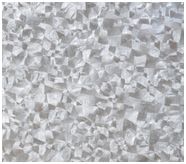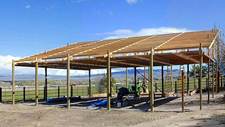When it comes to steel, we talk a lot about galvanization. Many post frame building products are galvanized to prevent premature decay. These include fasteners (screws , nails, nuts, bolts and washers), engineered steel hangers, the pressed in steel connector plates for trusses and components for sliding, overhead and entry doors.
Every year, steel corrosion costs the economy a small fortune. Corrosion, also known as rust, is a natural process which occurs when steel is exposed to the environment. It can be slowed, however, with a protection technique called galvanization, which is the coating of steel with a layer of zinc to slow the corrosion process. Zinc is used to protect steel because the zinc layer rusts more easily than steel but also rusts much more slowly than steel. Therefore, the underlying steel remains safe from rust for many years.
 There are two types of galvanizing: continuous and batch. Continuous galvanization occurs when zinc is applied to a ribbon of steel as it passes through a bath. This steel passes through the bath at very high speeds and is only in the bath for two to four seconds. Once it has been galvanized, the steel is then shaped into the final product. Despite this high galvanization rate, continuous galvanizing is limited in the fact that only very thin, flexible sheets of steel are able to be galvanized in this way. This limitation is due to the fact the steel needs to remain flexible so it can be formed and shaped later.
There are two types of galvanizing: continuous and batch. Continuous galvanization occurs when zinc is applied to a ribbon of steel as it passes through a bath. This steel passes through the bath at very high speeds and is only in the bath for two to four seconds. Once it has been galvanized, the steel is then shaped into the final product. Despite this high galvanization rate, continuous galvanizing is limited in the fact that only very thin, flexible sheets of steel are able to be galvanized in this way. This limitation is due to the fact the steel needs to remain flexible so it can be formed and shaped later.
Objects which have been galvanized in this manner include items used for roofing and siding sheets.
Batch galvanizing, also called after fabrication galvanization, is different from continuous galvanizing in that the steel is first shaped into its final shape and then immersed in a bath of molten zinc. Although batch galvanizing is not as fast as continuous galvanizing, one advantage is any shape of metal can be galvanized in this manner.
The three steps in the galvanization process are preparation, galvanizing, and post treatment. The preparation step consists of immersing the steel in three different cleaning baths prior to galvanization. First, the steel is immersed in a caustic cleaner, which is an acid bath which removes all dirt and grease. After being rinsed in a water bath, the steel is then cleaned with a pickling acid (usually either hydrochloric or sulfuric acid) to remove rust and mill scale. The steel is again rinsed with water. The final step the preparation process is soaking the steel in a flux solution, which cleans the steel of any oxidation which has happened since the pickling step and protects it from further oxidation before it enters the galvanizing bath.
The galvanizing bath consists of a minimum of 98% molten zinc heated to a temperature of around 850˚F. Once the steel reaches bath temperature, the zinc in the bath chemically reacts with the iron in the steel to form the layers which protect the steel. It usually takes less than ten minutes for the steel to reach bath temperature and to react with the zinc. The steel then undergoes a post-treatment process which varies with the facility. One of the most common post-treatment processes is quenching, which is when the steel is soaked in a quench tank to make a layer which protects steel during transportation.
Now you know how important galvanization is to the longevity of steel!








